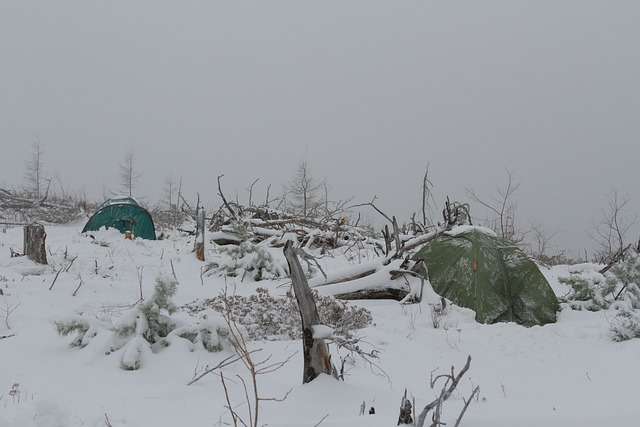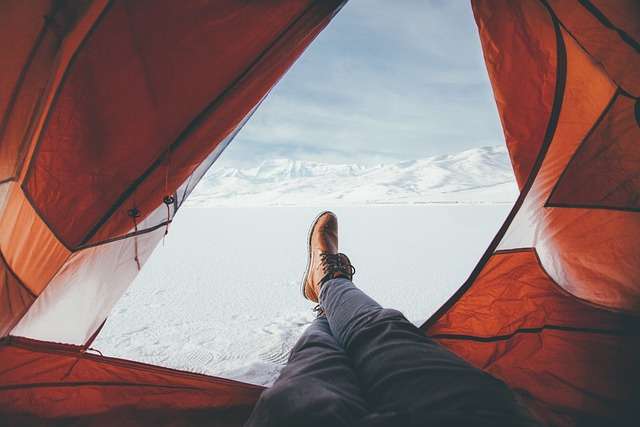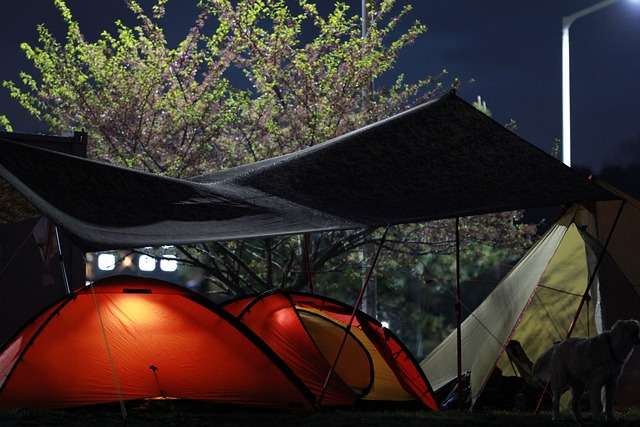Camping provides a unique opportunity to connect with nature, find tranquility, and rejuvenate your spirits. While many may associate camping with the sunny days of summer, hot tent camping has become increasingly popular among adventurers who want to embrace the beauty and serenity of winter. For explorers keen to embark on unforgettable winter adventures, hot tent camping is a comfortable, warm, and practical solution.
In this comprehensive article, we’ll explore what hot tent camping entails, why it has gained popularity, and how you can get started on this exciting journey.
What is Hot Tent Camping?
Hot tent camping, also known as stove tent camping, refers to an outdoor adventure that involves setting up a tent equipped with a wood-burning stove to keep the interior warm and cozy. The portable stove is placed inside the tent, with a chimney or stovepipe passing through a fire-resistant “stove jack” sewn into the tent wall.
Gaining popularity for its insulated shelter system, hot tents come in various sizes and materials, such as canvas, polyester, and silnylon. They are specially designed to provide a warm haven in cold winter months and chilly environments.

The Advantages of Hot Tent Camping
While hot tent camping may seem like too much of an investment for some, it comes with several advantages that make it an attractive and enjoyable option for camping enthusiasts. Below are a few key benefits:
- Winter Comfort: A wood-burning stove provides warmth, comfort, and a dry atmosphere, ensuring a pleasant camping experience even during cold and damp weather conditions.
- Cooking Solution: The stove doubles as a cooking platform, allowing you to warm and prepare meals without the need for an additional campfire.
- Snow Melting: In snowy conditions, the stove can quickly and easily melt snow for drinking water.
- Drying Clothes: The warm interior provides an excellent space to dry wet clothes and gear.
- Versatility: Hot tents can be used in a variety of settings, from backyard gatherings to hunting trips in the wilderness.
Choosing a Hot Tent and Stove
Selecting the right hot tent and stove is crucial to ensure a safe and enjoyable trip. Here are a few factors to consider:
- Tent material: Common materials include canvas, polyester, and silnylon. Canvas is a popular option for its durability and breathability, while lightweight alternatives such as silnylon may be better suited for backpacking adventures.
- Stove type: Options include traditional wood-burning stoves and compact portable stoves for backpacking. Consider factors such as fuel availability, efficiency, and the stovepipe’s location when deciding on a stove.
- Tent size: For maximum comfort and convenience, consider the amount of space you’ll need for sleeping, gear storage, and moving around inside the tent. Also, consider the number of occupants and the height of the stove.
- Fire safety: Ensure that the tent comes equipped with a fire-resistant stove jack and fire-retardant materials to minimize fire hazards.
- Ventilation: Make sure the tent has adequate ventilation to prevent carbon monoxide buildup and maintain indoor air quality.

Tips for a Rewarding Hot Tent Camping Experience
Planning a hot tent camping trip requires some preparation to ensure a smooth and enjoyable experience. Here are a few tips:
- Location: Choose a suitable location with level ground, shelter from the wind, and proximity to water sources. Double-check winter camping regulations, and make sure you obtain any necessary permits.
- Safety and first aid: Prepare a first aid kit and familiarize yourself with basic first aid knowledge. Also, pack essential equipment like carbon monoxide detectors and fire extinguishers.
- Proper gear: Invest in quality cold-weather gear, including clothing, sleeping bags, and insulating pads to ensure comfortable sleep.
- Insulation: Use a ground tarp and insulating pads to minimize heat loss and improve warmth inside the tent.
- Firewood: Carry enough firewood or have a plan to collect wood from your surroundings. Make sure to keep anything flammable away from the hot stove during operation and while cooling down.
- Chimney maintenance: Regularly check and clean your stovepipe to prevent chimney fires and maintain efficient stove operation.
- Ventilation: Keep a balaclava or buff handy to protect your face from chilly air when opening vents to maintain adequate air circulation.

Setup and Maintenance
Setting up your hot tent and stove may seem challenging at first, but with practice, it becomes easier to manage. Here are some steps and tips to help you set up and maintain your hot tent and stove:
- Choosing the best location: Find a level spot clear of snow and debris, preferably close to a water source and blocked from strong winds. Avoid areas with overhead hazards, such as tree branches and avalanche-prone slopes.
- Setting up the tent:
- Lay down a ground tarp, making sure to cover the entire tent floor.
- Assemble the tent frame and insert the poles, following the tent’s instructions.
- Secure the tent to the ground using stakes and guylines.
- Adjust the guylines and tent stakes as needed to create a taut, wind-resistant setup.
- Installing the stove:
- Place the stove inside the tent, aligning the stovepipe hole with the stove jack.
- Assemble the stovepipe, ensuring each section fits snugly and securely.
- Insert the stovepipe through the tent’s stove jack, making sure the seal is tight.
- Fire safety and carbon monoxide prevention:
- Place a fire-resistant mat underneath the stove to protect the tent floor and reduce fire hazards.
- Invest in a carbon monoxide detector and place it inside the tent at a recommended height.
- Regularly check and clean your stovepipe to prevent chimney fires and maintain efficient stove operation.
- Packing up:
- Allow the stove to cool completely before dismantling it.
- Remove any remaining ashes from the stove and dispose of them appropriately.
- Disassemble the stovepipe and tent, being cautious not to damage the stove jack.
- Fold the tent and ground tarp neatly, and store them in their respective storage sacks, along with your stove.
Hot Tent Camping Etiquette and Responsibility
To preserve the environment, wildlife, and the camping experience for others, it’s essential to practice Leave No Trace (LNT) principles and hot tent camping etiquette when exploring the wilderness. Some helpful guidelines include:
- Planned routes and permits: Research the area, obtain necessary permits, and follow established trails and regulations.
- Leave No Trace: Always pack out what you pack in, including trash and leftover food. Adhere to the LNT principles, which promote sustainable outdoor ethical behavior.
- Minimal impact: Camp at least 200 feet away from water sources, trails, and other campers to minimize your impact on the environment.
- Respect wildlife: Observe animals from a safe distance without disturbing them. Store food and scented items away from your sleeping area, using bear-resistant containers or bear hangs to avoid unwanted animal encounters.
- Be considerate of other campers: Keep noise levels down and respect fellow campers’ privacy and enjoyment of nature.
- Campfire responsibility: Use established fire rings, if available, and always douse campfires completely before leaving your site. In the case of a wood-burning stove, make sure to have a sufficient supply of firewood and only use dead wood from the ground.

Themed Hot Tent Camping Ideas
While hot tent camping can be enjoyed solely as a winter escape, there are various themed ideas to explore to make the experience even more delightful. These themed camping trips can add meaning and excitement to your outdoor adventure:
- Stargazing: Venture into a remote area or a designated dark-sky park to enjoy an unforgettable night of stargazing in the warmth of your hot tent.
- Winter photography: Capture the breathtaking beauty of winter landscapes, frost-covered trees, and wildlife as you embark on a hot tent camping trip.
- Ice fishing: Set up your hot tent near a frozen lake or river and spend your day’s ice fishing, exploring a unique and relaxing pastime in a wintry environment.
- Snowshoeing or cross-country skiing: Plan a backcountry hot tent camping trip with snowshoeing or cross-country skiing activities during the day, and return to a cozy, warm shelter in the evenings.
- Winter Retreat: Create a winter retreat experience by combining hot tent camping with activities such as meditation, yoga, journaling, or mindfulness practices.
Hot tent camping is a unique and rewarding experience that allows outdoor enthusiasts to explore the beauty of winter landscapes while staying warm and cozy. Investing in a durable and well-ventilated hot tent and appropriate camping gear ensures your trip is safe, enjoyable, and memorable. With proper planning, preparation, and awareness of essential safety measures, hot tent camping can become a favorite winter outdoor activity to embark on with friends and family.

Leave a Reply
You must be logged in to post a comment.